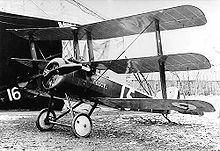Triplane
Alternatively, a triplane has reduced span compared to a biplane of given wing area and aspect ratio, leading to a more compact and lightweight structure.
This potentially offers better maneuverability for a fighter, and higher load-capacity with more practical ground handling for a large aircraft type.
The extra weight is partially offset by the increased depth of the overall structure, allowing a more efficient construction.
These advantages are offset to a greater or lesser extent in any given design by the extra weight and drag of the structural bracing and by the loss of lift resulting from aerodynamic interference between the wings in any stacked configuration.
No examples were successful, and as biplane design advanced, it became clear that the disadvantages of the triplane and quadruplane outweighed their advantages.
The first heavier-than-air machine to carry a human on a free, untethered flight was a triplane glider constructed by George Cayley and flown in 1848.
It was modern in form, having three stacked wings above the fuselage and a separate stabilising tail with both fin and tailplane.
In 1907 the Danish pioneer Jacob Ellehammer flew a powered triplane and would later receive a prize for flying it in Germany.
Alexander Graham Bell was experimenting with an "octahedral" wing design and in 1910 built a triplane example, the Oionus I, which failed to fly.
In practice these triplanes generally offered inferior performance to the equivalent biplane and, despite a brief vogue around 1917, only four types saw limited production.
The Sopwith type's performance advantage and early successes over the Albatros D.III spurred military interest in the design, especially in Germany and Austria-Hungary.
Examples were produced by Albatros, Aviatik, Brandenburg, DFW, Euler, Fokker, Friedrichshafen, LFG Roland, Lloyd, Lohner, Oeffag, Pfalz, Sablating, Schütte-Lanz, Siemens-Schuckert, W.K.F, in Britain by Austin and in the US by Curtiss.
The wings vibrated excessively in flight and the next prototype, the V.5, featured a single interplane strut on each side, similar to the Sopwith but with no wires called shrouds.
This became the prototype of the famous Fokker Dr.I triplane of 1917, which would become immortalised as the aircraft most closely identified in popular culture with Manfred von Richthofen, the "Red Baron".
Following the break-up of two examples in the air, the type was withdrawn from service for strengthening, and by the time it was re-introduced, it was no longer at the forefront of performance.
However, as late as 1919 three prototype Sopwith Snarks were flown, and in 1920 and 1921 the heavily armoured Boeing GA-1 and GA-2 ground-attack triplanes proved too heavy to be useful.
These were large three-seat types with twin engines and the middle wing of noticeably longer span than the others.
The Voisin design was unusual in having a subsidiary tail boom above the fuselage, helping to support the empennage.
The Levy-Besson Alerte of 1917 featured a central wing of greater span than the others and many examples were used for ASW and patrol duties.
He later developed a number of smaller designs for other roles, including Besson H-6 mail plane flown in 1921.
From 1918, the British company Bristol developed a series of heavy triplanes which, like the Caproni design, appeared in different variants aimed at different roles.
The power imbalance due to the high mounting caused the Tabor to crash on its maiden flight in 1919.
It was sold to Queensland and Northern Territory Aerial Services but proved unsuited to the tough conditions in the Australian Outback.
Britain's only triplane contribution to the maritime arena was the Felixstowe Fury prototype of 1918, also known as the Porte Super-Baby.
Also referred to as the Curtiss-Cox racer, being designed and sponsored by Cox from Texas and powered by a 435 hp (324 kW) Curtiss C-12 engine, the Cactus Kitten had a wingspan of 20 ft (6 m).
In 1927 a Catron & Fisk CF-10 twin-engined 22-seat airliner was modified with additional fuel tanks and updated engines and named the Pride of Los Angeles.
[14] Recently, the term "tandem triplane" has been used for some new monoplane types that have active "canard" foreplane surfaces in addition to conventional wings and horizontal tailplane.









